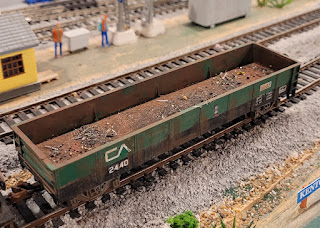Here is a simple, inexpensive car card and waybill system for freight car routing; which minimizes handling and makes routing obvious for old forgetful operators like me, and for new operators on your layout.
Materials:
- Baseball card toploader sleeves. Toploader means the opening is on the shorter side. (Amazon)
- Car cards, cardstock cut to baseball card size (3 1/2” x 2 5/8”)
- Waybills (cut from 3x5 index cards)
- Channel: vinyl outside-corner molding used for bathroom tile, UPC 70673 85883 (Home Depot)
- Elastic hair bands
Preparation
Create a list of standard abbreviations to include all possible freight car destinations on your layout. Use the same abbreviations consistently. I use three-letter abbreviations. Here is the list of abbreviations on my layout.
BOL Bolton Railcar Maintenance Facility
COM Commissary
CPR Chronicle Printing, Marias
CSH Cascade Section House
DAS Davis Passenger Station
DAV Davis Classification Yard
EEE EEE Feed and Supply, Marias
FRT Freight House and Team Track
GCF Glen Cove Fuels, Glen Cove
GCM Glen Cove Signal Maintenance Yard
KEL Kenton Electric Fabricators, Kenton
KEN Kenton Yard
KFF Kenton Freight Forwarders
LMS Leslie Marine Services, Marias
MMT Marias Machining & Tool, Marias
NPO North Portal Interchange
PAM Pamola siding
PSH Pamola Section House
PTC Precision Tooling Corporation, Marias
QUI Quinn Intermodal Yard
SPO South Portal Interchange
Install a channel all along the edge of the layout to hold the sleeves. It is helpful to label the destinations on the channel itself. The channel comes in 8 foot lengths, so it easy to just mount channel everywhere all along the edge of your layout. The channel has a flange which allows you to tack it in place from below, so no nails will be visible. Or you can just run a bead of adhesive on it and glue it in place.
channel material: vinyl outside-corner tile molding
car card/waybill rests in channel
Each freight car gets a Car Card. These are cut to baseball card size and show the reporting marks, car type, and destination for the car when empty. The Car Card is inserted into a baseball card sleeve,
car card in sleeve
Each sleeve/Car Card will always stay with its associated car.
When on the layout, the sleeve rests in the channel in front of the car.
When in transit, like the prototype, the waybills go along for the ride. A recycled margarine tub next to the power pack works well.
When off the layout, keep car and sleeve together by using an elastic hair band. These are soft and won’t mar your cars, and they won't dry out like rubber bands.
Waybills
Waybills are half-size cards which have a destination written on both front and back. The destination abbreviation is written in big red letters for easy viewing, so you need not pick up a card to read the destination. The waybill is inserted in the lower half of the sleeve so it is visible in front of the Car Card. With only two destinations written on the waybill, it is a 2-cycle waybill. You can also write the load information on the waybill if you wish.
waybill inserted
Operation
There is no car “storage” on my layout. Every car on the rails is in the process of going somewhere else. (The cars go in/out interchange tracks to/from a rolling storage rack, which represents all destinations beyond the layout). The abbreviation shows where the car is going NEXT. When setting out a car at a destination, the operator places the sleeve in the channel where it will remain.
car at destination
At the end of a session, all the cars are hopefully at their destination for the day. After a certain time has elapsed (typically, in between sessions), it is time to advance the waybills to prepare the cars for their next move. In each sleeve, turn the waybill over so the next location is showing. Now replace the sleeve in the channel, but place it standing
UP to indicate the car is ready to be picked
UP.
car ready for pickUP
To indicate an empty, just place the waybill BEHIND the car card so it cannot be seen, which reveals the empty routing instructions written on the lower half of the car card.
no waybill indicates empty car
Now when the train comes by, it is obvious to the operator which cars have recently been set out (the sleeves are horizontal, and waybill abbreviation matches the car’s current location); and which are ready to be picked
UP (the sleeve is standing
UP, and the waybill abbreviation shows a new destination).
This makes it easy to check that you delivered all your cars during the session. If you see any sleeves still standing UP, you still have work to do!
Making up trains
A length of channel can be mounted on the top of the layout in front of a sorting track, so the yard operator can clearly see which car is going where, and rearrange/block them in an efficient order as a train is made up. I just set the
cards in correct order first, then shuffle the
cars until they line up with the cards.
making up a train
Multiple tracks
Multiple channels can be mounted in front of multiple tracks, so the sleeves are arranged in the same pattern as the cars.































